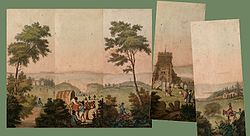
Myriorama
Encyclopedia

Myriad
Myriad , "numberlesscountless, infinite", is a classical Greek word for the number 10,000. In modern English, the word refers to an unspecified large quantity.-History and usage:...
of pictures, following the model of panorama
Panorama
A panorama is any wide-angle view or representation of a physical space, whether in painting, drawing, photography, film/video, or a three-dimensional model....
, diorama
Diorama
The word diorama can either refer to a nineteenth century mobile theatre device, or, in modern usage, a three-dimensional full-size or miniature model, sometimes enclosed in a glass showcase for a museum...
, cosmorama
Cosmorama
A cosmorama is an exhibition of perspective pictures of different places in the world, usually world landmarks. Careful illumination and lenses are used to give the images greater realism....
and other novelties. These were all part of a wider interest in viewing landscape as panorama, and in new ways of presenting "spectacular
Spectacle
In general, spectacle refers to an event that is memorable for the appearance it creates. Derived in Middle English from c. 1340 as "specially prepared or arranged display" it was borrowed from Old French spectacle, itself a reflection of the Latin spectaculum "a show" from spectare "to view,...
" scenes.
The early myrioramas were cards with people, buildings, and other images on compatible backgrounds, and could be laid out in any order, allowing a child to create a variety of imaginary landscapes. Jean-Pierre Brès, a French children's writer, published an early version which he described as a poly
Poly
Poly can have multiple meanings:* As a prefix, often meaning more than one or many * As a feminine given name...
optic picture (tableau polyoptique) in the early 19th century, and John Clark of London
London
London is the capital city of :England and the :United Kingdom, the largest metropolitan area in the United Kingdom, and the largest urban zone in the European Union by most measures. Located on the River Thames, London has been a major settlement for two millennia, its history going back to its...
took up the idea and designed a set of cards he called a myriorama. Clark's "second series" myriorama, an "Italian landscape", was produced in 1824, the same year as a similar set of English cards called a panoramacopia created by drawing teacher T.T.Dales. Reproductions of cards from the period are on sale today with other "traditional toys". Various contemporary artists have used the idea as inspiration for work they have named myriorama.
Later in the 19th century, the term "Myriorama" was used by the Poole Brothers to describe their popular moving panoramas; for a history of these, see the entry on Moving Panorama
Moving panorama
The moving panorama was a relative, more in concept than design, to panoramic painting, but proved to be more durable than its fixed and immense cousin. The word “panorama” is derived from the Greek words “to see” and “all.” Robert Barker invented the first panorama to describe his impressive...
.
Sources
- Jill Shefrin, Educational Games for Children in Georgian England, Princeton Library Journal
- French National Library
- Cambridge University Library
Further reading
- Ralph Hyde, Myrioramas, Endless Landscapes: The Story of a Craze, Print Quarterly, December 2004, XXI

